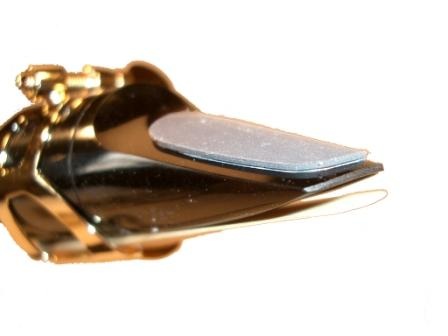Do You Need a Mouthpiece Patch?

As saxophone players, it’s clear that nothing occupies our thoughts on a daily basis more than the question, “Should I be using a mouthpiece patch or not?”
OK, I kid, but it is an interesting topic to look into as anything that can affect the “signal chain” of body to bell is something to be conscious of.
The Purpose of a Mouthpiece Patch

Why would you get one of these things? Quite simply, you slap one of these bad boys on so that you don’t leave teethmarks on your beloved mouthpiece over the course of years of playing.
For some sax players, the patch also helps reduce the sound vibrations from the mouthpiece onto the teeth, as those vibrations seem to irritate these players (I would assume that the effect would be similar to the bodily sensation of nails on a chalkboard).
Effects of the Mouthpiece Patch on Tone
I recently took part in a very interesting online forum discussion that was started by a great saxophone player who recently removed his patch and immediately noticed that his tone was obviously brighter and louder than it had been with the patch.
However, the general consensus of the other sax players in the forum was that the shift in tonal quality was nothing more than a perceived change. The reason being that the direct vibration of the teeth against the mouthpiece affected only way the instrument was vibrating within his head. Kinda like how when we hear recordings of ourselves speaking, we might be surprised to hear that our voice sounds different on the recording than it does when we hear it while we’re actually speaking.
In fact, members of the forum also chimed in that they had recorded themselves both with and without the patch and could hear no difference between the recordings.
I also got a bit of a consensus that the thinner patches seem to serve players better, as the impact on the way the piece feels in your mouth is reduced. Of course, if you’re looking to soften the feeling of the mouthpiece under your top teeth, then you can always go thicker.
The Conclusion
Since there seems to be no effects from the patch on your tone, I say slap one of these bad boys on. Tarnishing your lovely mouthpiece goofy teethmarks seems kinda silly.
BG makes a popular brand of mouthpiece patches, so you if don’t have any, you can grab some here.






December 7, 2010 @ 6:39 am
I like the reduction in vibration coupled into my upper teeth that the patch provides. It also seems to provide some traction so the mouthpiece doesn’t slip. Sounds silly, but if you’ve got a quick change from a double in a big band chart, it’s nice to quickly grab the sax and feel it securely in place.
December 7, 2010 @ 8:42 am
Hmm, never thought about the doubling aspect, but I totally agree! I too have had awkward instrument transitions due to the difference in embouchures (especially between clarinet and sax) and mouthpiece sizes. Great point, thanks Jeff!
August 9, 2011 @ 2:34 pm
In school we always just used Johnson and Johnson tape
August 9, 2011 @ 2:43 pm
That’s some ninja action that is! :-)
October 28, 2012 @ 9:49 am
Thanks i had a mouthpiece that the teeth marks almost made a hole (im exagerating of course) now that in going to buy a new mouthpiece of better quality this will help me
October 29, 2012 @ 9:38 pm
Glad that this article helped you! I think that the patch will keep your mouthpiece in great condition as long as you can get used to the slightly different feeling you get while playing on it.
January 7, 2013 @ 8:26 pm
I just bought a fancy new mouthpiece because my old one literally had bite marks ALL OVER IT…. There is a sticky thin thing on top of it and I think it’s a mouthpiece patch, but I don’t know because I just found out about them today. Biting is inevitable for me since I have sharp and uneven teeth, so will these things help?? I don’t think entering high school next year with a mouthpiece with bite marks all over it is a good idea.
January 7, 2013 @ 9:04 pm
Sounds like the patch is worth a try, especially if you have sharp teeth. I mean, protecting the mouthpiece from teeth marks is one of the major functions of the patch. I’d say go for it!
January 8, 2013 @ 7:56 pm
Great, I just got a nice one! :) But another question: is it okay to have bite marks on the patch?? Is that the point?
January 8, 2013 @ 9:41 pm
Awesome! And you’re exactly right, bite marks on the patch mean that the patch is doing it’s job. And if the patch gets too indented, you can always swap it out for a new one – which is more than you can say, of course, for a mouthpiece. :-)
February 15, 2013 @ 3:18 pm
hey guys, quick question: my mouthpiece have nothing on the bite plate, and i just bought transparent patches for it, but i was wondering if normally the mouthpiece should have another black pad on witch you should put the transparent ones,or that those black pads are the same thing, only black, and so i should just install the one i bought directly on the MP.
thank.
Roy.
February 16, 2013 @ 5:02 pm
I think you’re OK with just the one transparent patch. Too much padding and you’ll feel as though your sound is stuffy (your tone will actually sound the same, but the way the sound vibrates in your head will be altered, making it feel as though your sound is muffled).
February 16, 2013 @ 5:10 pm
thnks!
February 20, 2013 @ 6:59 pm
As a tenor sax player who has succummed to a full upper denture.(I’m 75) I find the patches help quite a lot to prevent slipping.
February 20, 2013 @ 9:51 pm
Ahh, I never thought of the benefit to those wearing dentures – I’m glad to hear that the patch helps keep you playing!
January 6, 2021 @ 12:52 pm
Hi. I wonder if you are still playing. You were 75 years old eight years back when you posted. I hope John that this message finds you well.
March 13, 2013 @ 7:28 am
I have sharp uneven teeth too, I practice around 2 hours daily and have worn out the patch by the end. I then take it off and turn it around. Thus a patch lasts me 2 days. That gets expensive over a year. I don’t like the idea of teeth marks in my yanigasawa mouthpieces so guess I just have to put up with it. I always thought there must be a way to buy the sticky back rubber in late sheets and cut my own. Just never found out where to buy it from.
June 9, 2013 @ 6:15 pm
I like the clear patches made by Runyon. The thicker black ones feel squishy to me. When I was in the Navy and Army Bands the mpc patches helped me to keep the mpc from slipping and sliding when we were doing a parade etc. Those pot holes in a field can be dangerous!!
August 12, 2013 @ 8:14 am
Doron: I like the thinner clear patches made by Runyon. The thicker black patches feel squishy. I started using them so them on clarinet so the mpc wouldn’t slide around while marching. Then I put them on my tenor and alto mpcs to protect the bite plate and beak.
August 12, 2013 @ 10:03 am
Yeah, I think that the bare minimum thickness is ideal, it really muffles yor perfection of the sound otherwise.
May 23, 2014 @ 2:41 pm
I’m buying a new mouthpiece 4 years later than I should have to replace my student mouthpiece, but I’m finally going to start taking my practicing and playing seriously.
My old mouthpiece was plastic, and it has two very distinct teeth mark scratches along the top gained over a period of 8 years of using it exclusively. That being said, is a mouthpiece patch something to consider for a metal mouthpiece? Certainly it is made of more durable material, but all the same I don’t want to risk it being scratched up by my sharp teeth.
May 23, 2014 @ 8:15 pm
Dave: Yes the mpc patches work well on metal mpcs. Each last me several years and they are inexpensive. As I stated above I like the thin clear ones made by Runyon. The thicker black ones feel squishy to me.
If you even have a slight chipped tooth or sharp teeth they are a really good idea.
If you are looking for a really good metal mpc and you pay tenor check out the CE Winds mpcs. They are 100% hand made in Florida and they are less expensive than other brands.
Best of luck to you.
April 6, 2015 @ 6:14 pm
I have sharp teeth and also I hate vibrations. I use a thin transparent stuck on first. Then a thick black one on top. I figure both will filter out different fequencies but that’s just a guess.
Beechler Bellite alto. Berg Larsen s/s (60’s) tenor.
Think I read John Coltrane used automobile tyres!
April 6, 2015 @ 6:25 pm
PS: Mine were made by BG clear and black, all sizes. Google them. Around £5 for a six pack. Share with a friend.
Also like the BG straps with metal hook – I don’t trust plastic – but watch it does not ‘unhook’ itself.
Had a leather strap snap once, caught my Mk VI on my foot! Not good for the heart.
Ray Hyman were the best – absolutely nonslip but no longer with metal hooks.
July 20, 2016 @ 6:29 am
I noticed I don’t need a patch anymore: I use more air-pressure now and have loosend up my embouchure. The result is a bigger, louder and more controlled sound. The teethmarks on my Meyer M6 showed I used too much teeth pressure. I need to rework that piece after 20 years of 1st alto abuse ;)
November 8, 2016 @ 2:02 pm
Are they dishwasher safe while on my mouth piece?
December 31, 2016 @ 11:48 am
Eve,
I don’t think it is a good idea to run your mouthpiece through a dishwasher. The detergents are very strong and the temps get pretty high. Both of which MAY, operative term here, cause damage to your mouthpiece
August 14, 2018 @ 5:40 pm
Black electrical tape works perfectly. One roll of the tape will last you for many years.
January 29, 2020 @ 12:17 pm
My grandson plays the alto saxophone, he’s in the 6th just starting out. I bought the clear patch for him. I was wondering if this will help with his bottom feeth hurting when he blows? Can I put one on the top and bottom?
October 2, 2021 @ 8:43 am
You can use wax covered gauze to put over the bottom teeth if they are cutting the bottom lip.
February 10, 2020 @ 3:12 pm
Do bite Mark’s on a mouthpiece affect the sound of the saxophone?
June 16, 2021 @ 7:19 am
I have had one of those old white brillhart mouthpieces for about 25 years. It’s starting to get worn down, especially on the right side. The patches I put on them won’t stay on because of the uneven surface. After ten minutes the patch starts sliding around.The moisture from my saliva effects their glue. I keep trying different patches but nothing works.
Can you think of a non toxic way to keep the patch on?Otherwise the mouthpiece will be worn through very soon…